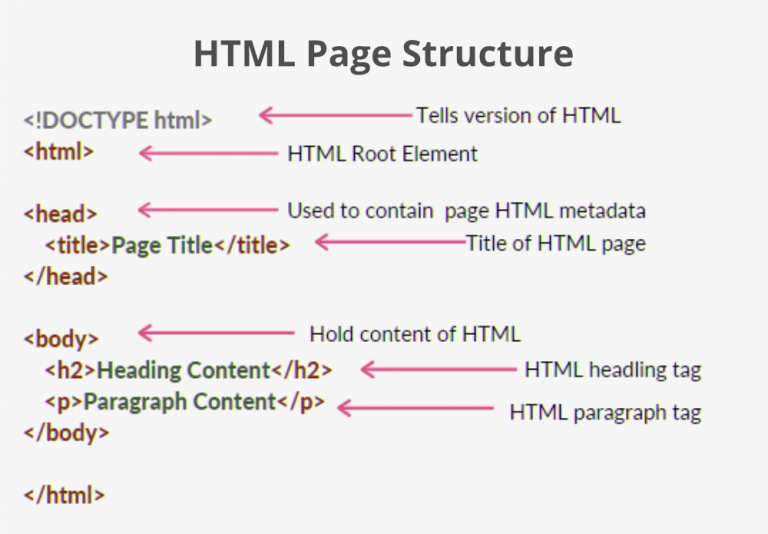What is HTML?
- HTML stands for Hyper Text Markup Language
- HTML is the standard markup language for creating Web pages
- HTML describes the structure of a Web page
- HTML consists of a series of elements
- HTML elements tell the browser how to display the content
- HTML elements label pieces of content such as "this is a heading", "this is a paragraph", "this is a link", etc.
Example Explained
- The
<!DOCTYPE html>declaration defines that this document is an HTML5 document - The
<html>element is the root element of an HTML page - The
<head>element contains meta information about the HTML page - The
<title>element specifies a title for the HTML page (which is shown in the browser's title bar or in the page's tab) - The
<body>element defines the document's body, and is a container for all the visible contents, such as headings, paragraphs, images, hyperlinks, tables, lists, etc. - The
<h1>element defines a large heading - The
<p>element defines a paragraph.
What is an HTML Element?
An HTML element is defined by a start tag, some content, and an end tag:
The HTML element is everything from the start tag to the end tag:
HTML Elements and Tags
HTML uses predefined tags and elements that instruct the browser on how to display the content. HTML elements include an opening tag, some content, and a closing tag. It’s important to remember to include closing tags. If omitted, the browser applies the effect of the opening tag until the end of the page.
This section will dive into the basic structure of an HTML page, which includes essential building-block elements like doctype declaration, HTML, head, title, and body elements.
HTML Page Structure
The basic structure of an HTML page is shown below. It contains the essential building-block elements (i.e. doctype declaration, HTML, head, title, and body elements) upon which all web pages are created.

- <!DOCTYPE html> – This is the document type declaration (not technically a tag). It declares a document as being an HTML document. The doctype declaration is not case-sensitive.
- <html> – This is called the HTML root element. All other elements are contained within it.
- <head> – The head tag contains the “behind the scenes” elements for a webpage. Elements within the head aren’t visible on the front end of a webpage. HTML elements used inside the <head> element include:
- <style> – This HTML tag allows us to insert styling into our web pages and make them appealing to look at with the help of CSS.
- <title> – The title is what is displayed on the top of your browser when you visit a website and contains the title of the webpage that you are viewing.
- <base> – It specifies the base URL for all relative URL’s in a document.
- <noscript> – Defines a section of HTML that is inserted when the scripting has been turned off in the user’s browser.
- <script> – This tag is used to add functionality to the website with the help of JavaScript.
- <meta> – This tag encloses the metadata of the website that must be loaded every time the website is visited. For eg:- the metadata charset allows you to use the standard UTF-8 encoding on your website. This in turn allows the users to view your webpage in the language of their choice. It is a self-closing tag.
- <link> – The ‘link’ tag is used to tie together HTML, CSS, and JavaScript. It is self-closing.
- <body> – The body tag is used to enclose all the visible content of a webpage. In other words, the body content is what the browser will show on the front end.
An HTML document can be created using an HTML text editor. Save the text file using the “.html” or “.htm” extension. Once saved as an HTML document, the file can be opened as a webpage in the browser.
Web Browsers
Unlike other programming languages, HTML does not show output on the compiler.
Web browsers show the results of an HTML code. It reads HTML files and determines how to show content with the help of HTML tags.
Any web browser (Google, Safari, Mozilla Firefox, etc) can be used to open a . HTML file and view the results.
Why learn HTML?
- It is a simple markup language. Its implementation is easy.
- It is used to create a website.
- Helps in developing fundamentals about web programming.
- Boost professional career.
HTML History
HTML is a markup language used by the browser to manipulate text, images, and other content, in order to display it in the required format. HTML was created by Tim Berners-Lee in 1991. The first-ever version of HTML was HTML 1.0, but the first standard version was HTML 2.0, published in 1995.
Advantages of HTML
- HTML is used to build websites.
- It is supported by all browsers.
- It can be integrated with other languages like CSS, JavaScript, etc.
Disadvantages of HTML
- HTML can only create static web pages. For dynamic web pages, other languages have to be used.
- A large amount of code has to be written to create a simple web page.
- The security feature is not good.
Conclusion
In conclusion, mastering HTML is a fundamental step in your web development journey. This guide serves as a comprehensive resource for understanding HTML, from the basics to more advanced topics. Remember, HTML is more than just a markup language – it’s a powerful tool for creating engaging, accessible, and SEO-friendly websites.
thanks for visite to this Website guys✌👇👇😉👐 ....................
👇👇🙏🙏 please support to my social media accounts




No comments:
Post a Comment